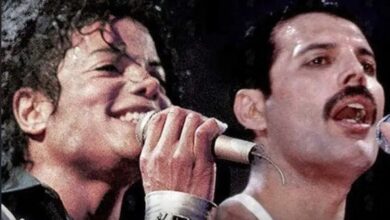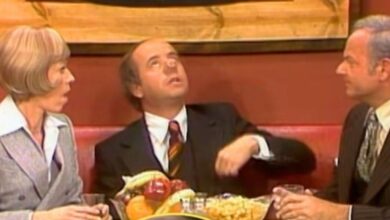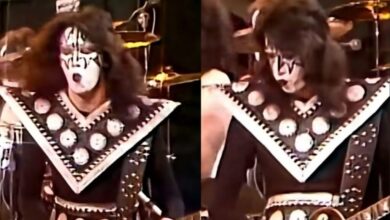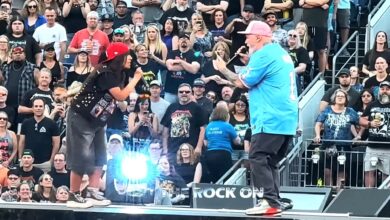Erik Grönwall Transforms “O Holy Night” into a Powerful Modern Christmas Anthem
The announcement arrived like a quiet miracle: Erik Grönwall, the electrifying vocalist who rose to fame after winning Idol in 2009 and later fronted both H.E.A.T and Skid Row, unveiled a transcendent version of “O Holy Night.” Filmed inside a dimly lit church, it wasn’t just a seasonal song—it was a cinematic expression of renewal and faith. Known for igniting stages with thunderous energy, here he channeled that same fire into calm devotion, each syllable trembling with gratitude and purpose, turning performance into prayer.
Fans had sensed something extraordinary even before its release. A brief teaser hinted at a December 13 premiere at 5 p.m. CET, filmed under the warm invitation of Alunda Församling, the Swedish parish that opened its doors for the recording. The setting itself whispered reverence: raw acoustics of wood and stone, candlelight flickering against the silence. No post-production gloss, no studio filters—just natural sound and sacred stillness. When it finally debuted, the first frame—flames dancing against shadow—announced something pure and timeless had arrived.
The performance begins with fragile restraint, his voice barely breaking the still air. Each line flows slowly, like a whispered confession, anchored in awe. Subtle piano tones ripple beneath, soon expanding into orchestral warmth as the melody climbs. By the song’s climax, his voice ascends with effortless majesty—every high note resonating like light bursting through glass. This transformation from fragility to triumph captures decades of discipline, proving that true vocal mastery isn’t about power alone, but knowing when to surrender to the music’s spirit.
Beneath its beauty lies a deeper story of survival. After his leukemia diagnosis in 2021, Grönwall faced a grueling bone-marrow transplant and a long, uncertain recovery. His return to health became a beacon of hope within the rock world. By 2024, having stepped away from Skid Row to heal, he redirected his strength inward. “O Holy Night” emerged not as a comeback, but as a confession—a song reborn through someone who had faced mortality and found grace in the echo of a second chance.
The visuals match that spiritual rebirth with delicate precision. The church is lit only by candles, each flame reflecting softly on weathered stone. There are no quick cuts, no dramatic flourishes—just quiet observation. When the final crescendo swells, the camera moves close enough to capture a flicker of emotion in his eyes, an unspoken acknowledgment of everything he’s endured. It’s artistry stripped bare, showing how sincerity and stillness can pierce deeper than any spectacle could ever dream.
Within days, the video spread like a wave of light through the digital world. View counts surged into the hundreds of thousands, fueled not by marketing but by awe. Viewers who once shared rock solos or tour clips now shared a hymn. Grönwall later mentioned that the video was gaining over 100,000 views daily and would soon be on all major platforms. It wasn’t just viral—it was devotional, passed from listener to listener like a blessing.
What gives the performance its lasting power is balance—strength wrapped in serenity. His rock-sculpted voice gives the hymn muscle, but never overwhelms its sacred core. Each breath feels deliberate, each pause meaningful. The climactic phrase lands with the weight of revelation, not performance. The pacing feels cinematic, as if charting a spiritual ascent—from hushed reverence to luminous transcendence—fusing the grandeur of an arena anthem with the intimacy of a midnight prayer.
Critics and fans alike reacted with raw emotion. Vocal coaches marveled at his control and seamless tone shifts, while metal audiences celebrated the quiet fire beneath the reverence. Faith-based listeners called it healing. Comment sections filled with words like “tears,” “goosebumps,” and “chills.” For once, there were no genre divides—just humanity responding to sincerity. Everyone seemed to agree: this wasn’t just a Christmas cover, it was a living moment of unity carved in sound.
Recording inside a real church gave the music its divine pulse. Every note echoed through vaulted ceilings, vibrating with warmth that no studio could replicate. The walls themselves seemed to breathe with him, their stone texture adding a natural reverb that wrapped each phrase in holiness. When the final tone fades, the silence feels alive—like shared prayer between artist and space. That unfiltered realism becomes its own act of worship, proof that the sacred can still dwell within simplicity.
This performance also marks a return to his musical beginnings. Before fame and electric stages, Grönwall sang in small community choirs, learning harmony and discipline before discovering the freedom of rock. Illness pulled him back to those origins, reminding him that music heals long before it entertains. In “O Holy Night,” those two worlds merge—the purity of the choirboy and the roar of the frontman intertwined in harmony, transforming past struggles into luminous serenity.
Technically, it’s a showcase of precision and poise. His vowels open fully for resonance, the diaphragm supports each long phrase, and his climactic “divine” soars without even a hint of strain. The resonance lingers naturally, like air vibrating with light. Even those unfamiliar with vocal craft feel its impact instinctively—the mix of tension and release, fragility and strength. This is technique elevated to emotion, discipline disguised as grace, leaving a lasting sense of catharsis in every listener.
Even the smallest gestures speak volumes—a fleeting smile, a gentle breath as the last note fades, a brief glance toward the heavens. None of it feels rehearsed; it’s pure presence, caught unguarded. In a culture obsessed with perfection, this honesty feels radical. The unfiltered humanity behind those moments makes it impossible to look away, reminding us that vulnerability, when offered without fear, becomes the most powerful form of strength an artist can give.
Its December release only deepened the emotional connection. Listeners folded it into their winter rituals, playing it alongside sacred traditions and quiet nights. Each year, as candles are lit and snow gathers outside, it returns like a memory wrapped in comfort. Fans flooded his inbox requesting an audio version, solidifying its place among modern holiday classics. The timing felt divine—proof that sometimes music finds its way into people’s hearts exactly when the world needs it most.
To Swedish audiences, the performance held another layer of meaning. “O Helga Natt,” beloved across Scandinavia, carries generations of heritage. Though sung in English, Grönwall’s version radiated Nordic tranquility—the candlelit stillness of Lucia night fused with the passion of global rock. In that merging of cultures, he built a bridge between tradition and innovation, creating something at once deeply local and universally human. It felt like Sweden’s soul, illuminated for the world to see.
At its heart, “O Holy Night” became more than a song—it was a resurrection story told through melody. It proved that even a voice forged in the chaos of rock can channel grace when stripped to its essence. Every December, new listeners stumble upon it and fall silent, while old fans return seeking peace. That shared hush, that collective stillness, has become its legacy—a thousand candles glowing from one voice reborn in light.
Soon after, Grönwall extended this creative awakening to other timeless pieces. His raw, heartfelt take on Mariah Carey’s “Without You” blurred the line between vulnerability and power, while his interpretation of Whitney Houston’s “I Will Always Love You” stunned audiences with equal parts precision and soul. Each performance felt like a revelation, reminding listeners that a rock singer’s strength lies not in volume but in the courage to feel—proof that emotion transcends every genre boundary.
Grönwall’s ongoing evolution continues to inspire those who follow his journey. By blending humility with intensity, reverence with rebellion, he reminds the world that music’s real strength lies in its ability to move hearts, not just ears. “O Holy Night” stands as his defining masterpiece—a declaration of faith, survival, and artistry. When that final note fades into silence, it leaves behind more than sound—it leaves gratitude, glowing quietly like hope that refuses to die.





